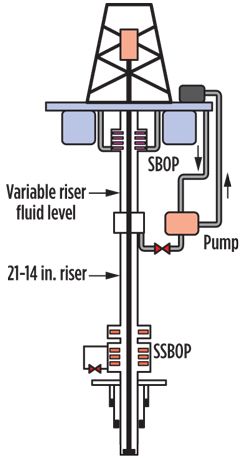|
Further to, and continuing from, the Forward Thinking Technology section of my column in the June 2013 issue of World Oil, operator asset teams are always looking for better ways to get as much advanced information from the wellbore and reservoir formation as they can. Achieving this with minimal risk and maintenance of safety is of upmost importance. Technology for obtaining real-time formation information (commonly from log technology), while drilling, has improved over the years. These tools contain radioactive sources, which could be a risk during transportation, storage, and handling at the rig site, and which are potential environmental concerns. If lost/stuck in the wellbore, they would need to be recovered. The continuation of this column, below, describes some forward-thinking technology that could possibly provide this information. Our industry has been successful over time, because we have continued to develop new technology to make operations safer, save more time, and improve cost-effectiveness, using best practices. Forward-thinking technology. Managed Pressure Wellbore Control includes the drilling and completion phases of the well operation. Coupled with Formation-Pressure-While-Drilling (FPWD) measurements, it may provide an aid in setting boundaries, especially in HPHT exploration and exploitation wells. As regards underbalanced and managed pressure drilling (MPD), IADC has defined it as an adaptive drilling process, used to control the annular pressure profile precisely throughout the wellbore. It ascertains the downhole pressure environmental limits and manages the annular hydraulic pressure profile accordingly. The technology process avoids continuous influx of formation fluids to the surface. Any incidental flow will be contained safely by use of an appropriate process. The MPD process uses tools and techniques that may mitigate the risks and costs associated with drilling wells that have narrowed, downhole environmental limits, by managing the annular hydraulic pressure profile proactively. MPD may include control of backpressure, fluid density, fluid rheology, annular fluid level, circulating friction and hole geometry, or combinations of all of them. MPD may enable faster corrective action to deal with observed pressure variations. Controlling annular pressures dynamically facilitates drilling of what would be economically unattainable prospects.
Overbalanced drilling (OBD) has been the method of choice for most wells drilled since the early 20th century. The drawback is its dependency on multiple casing strings to prevent fluid loss, due to density increases, and as ECD approaches formation fracture initiation pressure. In ultra-deep water, pore pressures may be high, relative to formation strength, even in shallower depths. This results in numerous casings before reaching the target formation. Thus, the diameter through the producing formation is too small to accommodate production casing and tubing, to produce economic volumes of hydrocarbons. Mud filtrate and solids can be an issue, along with potential differential sticking of the drillstring. Maintaining ECD below fracture gradients in horizontal sections can also be an issue. Managing drilling fluid properties, flowrates and penetration rates is being implemented. A micronized weighting fluid has been developed, with particles 10 times smaller than conventional barite. The MPD technique is a closed system approach, compared to conventional open systems. The FPWD tool provides direct, real-time measurement of formation pressure and mobility. The tool is a probe-type formation tester, similar in design and operation to conventional wireline formation testers. Use of the FPWD tool controls the pre-test, to provide the correct rate and volume to yield a stable pressure. The parameters of the pre-test may be either fixed or downhole-variable. Taking pre-tests for drilling applications, such as a pore pressure calibration, can be challenging, given the very dynamic nature of the wellbore and near-wellbore formation, shortly after drilling that section. Lack of mud cake seal can cause supercharging, which can lead to non-representative formation pressures, and continuous invasion and secondary supercharging from mud circulation during the pre-test. This needs to be observed. Use of the data obtained with the FPWD and MPD technologies needs to be carried through to the completion phase, commencing with installation of the casing strings, along with the cementing design and installation procedure, through to the completion of the producing reservoir. MPD development and practice, and the equipment required to execute it, have been demonstrated in wells in Australia and the U.S., in mature fields and in HPHT environments. |
- Coiled tubing drilling’s role in the energy transition (March 2024)
- Advancing offshore decarbonization through electrification of FPSOs (March 2024)
- Subsea technology- Corrosion monitoring: From failure to success (February 2024)
- Using data to create new completion efficiencies (February 2024)
- Digital tool kit enhances real-time decision-making to improve drilling efficiency and performance (February 2024)
- E&P outside the U.S. maintains a disciplined pace (February 2024)



